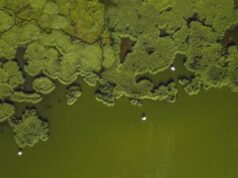Chematic of a sandstone sample receiving CO2 injection, indicating the difference in detail in the simple typical model (left) and the more realistic digital rock model used in the study (right). The greater detail provided by the digital rock model can help to identify the relevant processes of CO2 movement and the rock’s potential for CO2 storage in natural rock reservoirs.Credit: International Institute for Carbon-Neutral Energy Research (I2CNER), Kyushu University
Carbon capture and storage (CCS) is a relatively new method for capturing carbon dioxide (CO2) emissions from power stations and industrial processes and pushing the greenhouse gas underground to prevent it from entering the atmosphere. Suitable locations for CCS include depleted oil and gas fields or deep aquifers. A detailed understanding of the passage of fluid within the rocks of these target locations is imperative for ensuring that CO2 is stored effectively and leakage risk is minimized.
This level of detail naturally requires state-of-the-art techniques, and one such method is under development at Kyushu University’s International Institute for Carbon-Neutral Energy Research (I2CNER) and Department of Earth Resources Engineering.
“The idea is that if we can generate a detailed and realistic model of the target reservoir rock, we can precisely determine how the CO2 will displace water,” lead and corresponding author Takeshi Tsuji of I2CNER explains. “We can then use the model to help us to estimate the storage capacity and leakage risk for CO2 capture below ground.”
There have been many studies of the passage of CO2 through porous rocks, but these rely on relatively simple computer models that typically assume the pores are the same size and shape and are spread uniformly through the rock. “These techniques, and simple laboratory simulations, limit our ability to understand a broad range of potential CO2 storage reservoirs below ground,” study coauthor Fei Jiang says.
The researchers scanned the rocks using X-ray microcomputed tomography, a similar technology to that used in hospitals to see inside the human body, and combined the results with detailed mathematical simulations. Using this “digital rock model,” they were able to generate a picture of the real displacement of water by CO2 below ground and identify the optimal conditions for CO2 storage in real rocks.
Find your dream job in the space industry. Check our Space Job Board »
The application of this approach to a sandstone sample allowed the researchers to examine the movement of fluids inside the rock at an unprecedented level of detail. This enhances understanding of the processes that occur at the micro-scale inside the rock as CO2 is injected. “We were able to identify the main regime for fluid displacement inside our sandstone sample,” Tsuji explains, “and because of the properties of our sandstone, we can determine which processes are most dominant in natural rocks that could be used for CO2 storage.” In the future, if rock samples are available from a potential reservoir, the method could be used to analyze rock’s storage potential and contribute to advancement of CCS as a viable technique for CO2 removal.
The article “Characterization of immiscible fluid displacement processes with various capillary numbers and viscosity ratios in 3D natural sandstone” was published in Advances in Water Resources.
This article originally appeared at Kyushu University, I2CNER.
Journal References:
- Takeshi Tsuji, Fei Jiang, Kenneth T. Christensen. Characterization of immiscible fluid displacement processes with various capillary numbers and viscosity ratios in 3D natural sandstone. Advances in Water Resources, 2016; DOI: 10.1016/j.advwatres.2016.03.005











